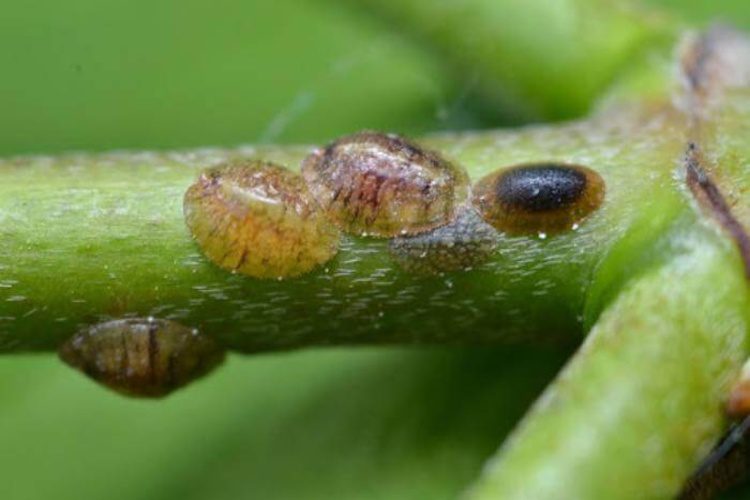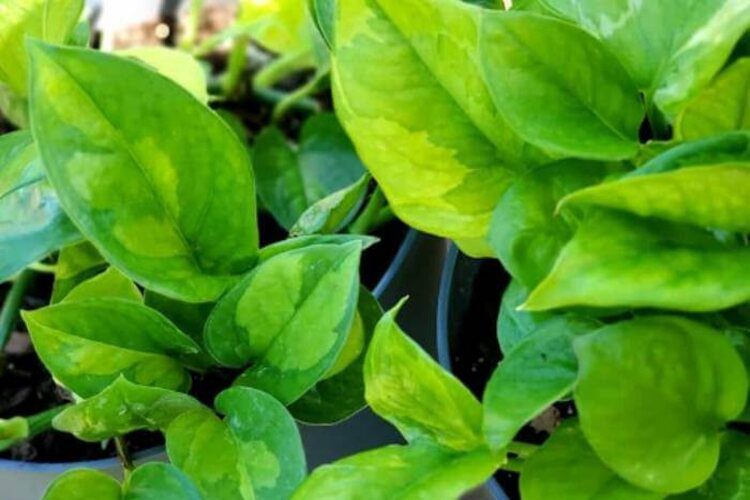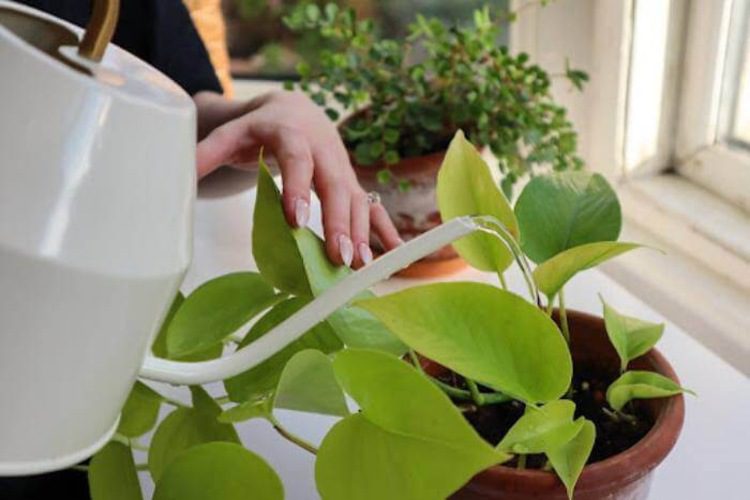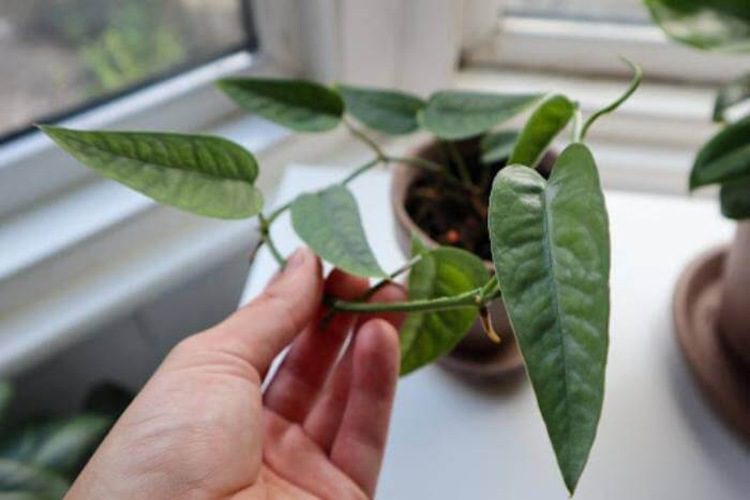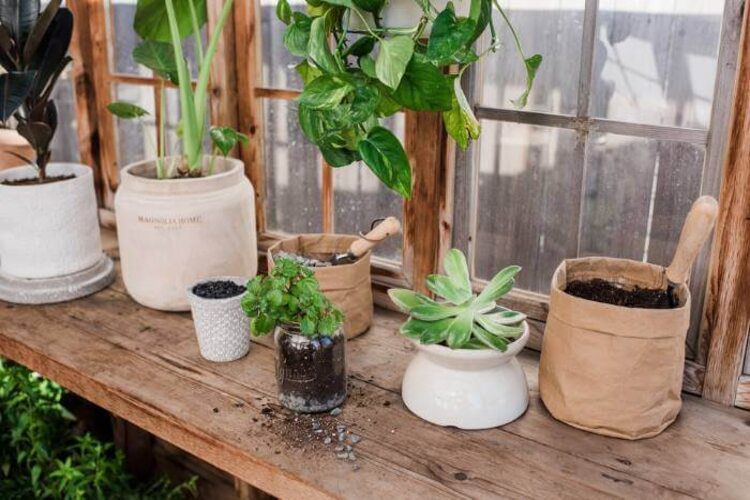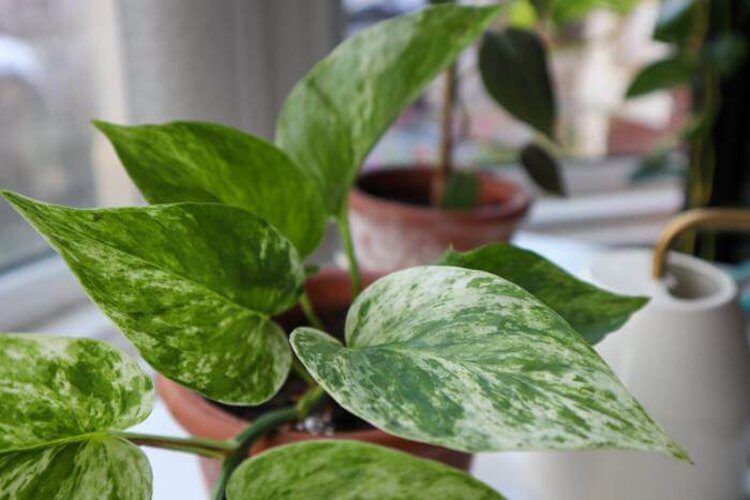16 Types Of Pothos You Will Love to Grow
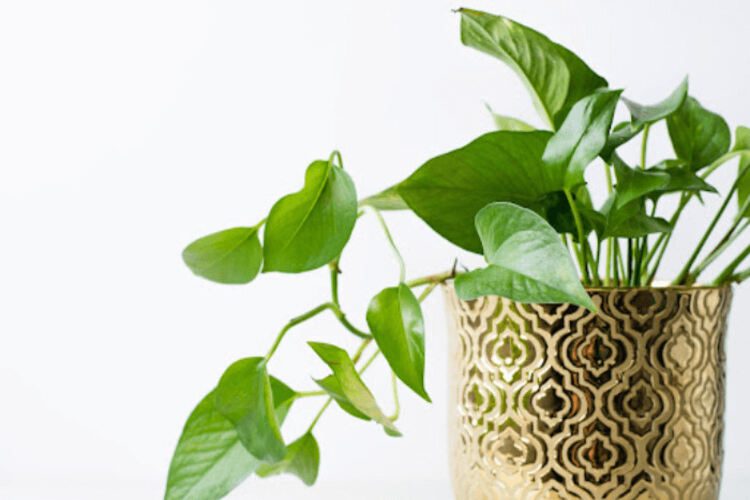
Pothos is regarded as one of the easiest houseplants to care for; provide them with medium light sources, timely watering, and regular pruning, and you will have satisfying hanging baskets of ornaments.
With such demanding characteristics, Pothos is a sought-after houseplant for many gardeners. The fact is that there are many kinds of pothos plants available. Now we will list the 16 most common varieties of Pothos. Read on to gain insights about each of them, and you might have your own choice regarding your preference.
How Many Types of Pothos Are There?
There are 16 different species of pothos. They have misleading names and the usual similarities in features such as variegation patterns, size, and growing demand.
The appearance of your pothos will vary depending on the variety you have. Each kind has unique aesthetic sides and is sometimes slightly different from one another. And you might think it’s interesting to tell apart these pothos types.
Golden Pothos
Scientific name: Epipremnum aureum
Being the most traditional pothos, you can easily find Golden Pothos in every nursery and local garden. Its botanical name is also identical to the family name of Pothos (Epipremnum aureum).
Although it’s the most ubiquitous, it’s not less good-looking than any other cultivar. The heart-shaped leaves feature a typical variegation of medium green and creamy gold. The trailing vines grow quickly, grip surfaces, and cling to them. Sometimes they even have an invasive tendency in some well-conditioned areas, like their natural habitats, which are humid tropical climates.
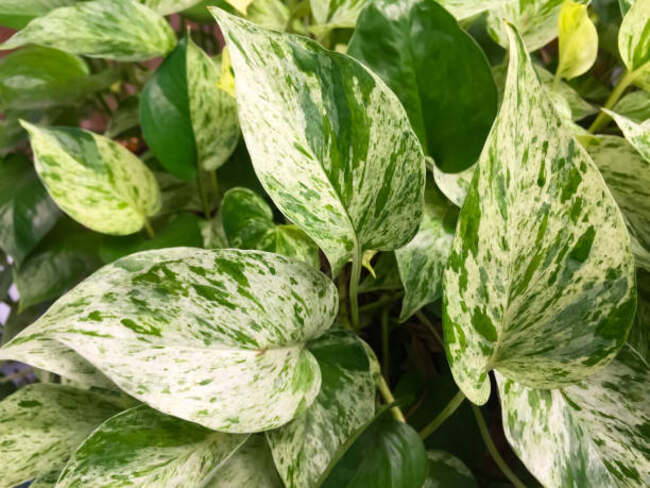
Marble Queen Pothos
Scientific name: Epipremnum aureum ‘Marble Queen’
Another popular pothos that gained much attention from indoor gardeners. As one of the earliest Pothos cultivars, it is easy to find and grow. As a highly variegated plant, it resembles marbling, just like its name; the foliage variegation has characteristic patterns of a colored quilt with bright white spots blended seamlessly into the green.
Marble Queen Pothos is usually mistaken for Golden Pothos or sometimes for Manjula. But the biggest difference is in the white streaks, which are smaller and denser than those of both cultivars mentioned. Besides that, it is the same size as Golden. The color pattern modifies itself with the lighting conditions, making it an ever-changing plant that dazzles you at some points. This cultivar is indeed the “Queen” of the variegated pothos world.
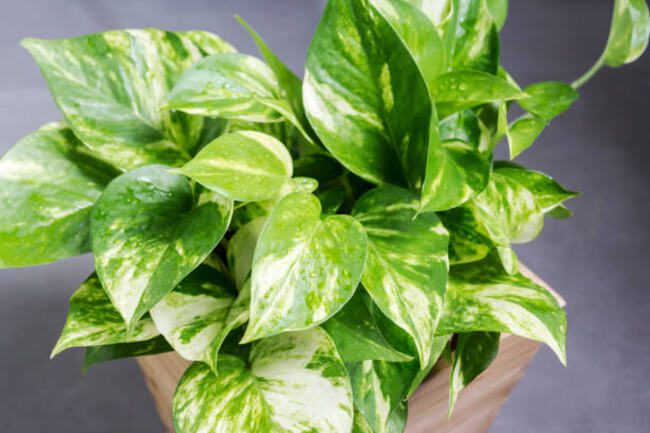
Neon Pothos
Scientific name: Epipremnum aureum ‘Neon’
Neon pothos might be one of the unique varieties. The leaves are also heart-shaped, but the color is bright, somewhere from golden yellow to neon, sometimes appearing almost luminescent. It totally lacks the variegation that is the signature of pothos. However, its invariant bright-green look makes it stand out amongst other pothos in the same way.
There is a change in the shades of color as the foliage ages. New leaves capture a brighter color that deepens gradually over time. Also, the leaves modify their shade along with the light conditions they receive. For example, when receiving less sunlight, the leaves will have a duller green tint than normal, and vice versa. It is special, so don’t mistake the bright leaves for being spoiled or unhealthy.
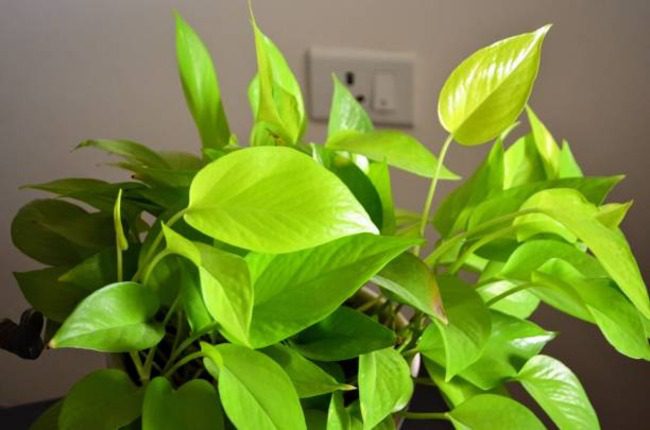
Jessenia Pothos
Scientific name: Epipremnum aureum ‘Jessenia’
However, it remains one of the latest cultivars that have been introduced since 2014; as such, it remains pretty low in number at the moment. The variegated pattern on Jessenia is quite similar to that on the Marble Queen, in which the color streaks splatter in a fuzzy way. The difference comes from the color of the foliage, as Jessenia possesses markings of light lime green instead of creamy gold.
The variegation is, therefore, tenuous and muted. There is not a large area of fixed color but numerous flakes on the leaves. But the muted nuance of the plant doesn’t correspond with a boring cultivar. In fact, it is considered a more “softened” version of its parent, Golden Pothos, and is favored by those who enjoy the subtlety.
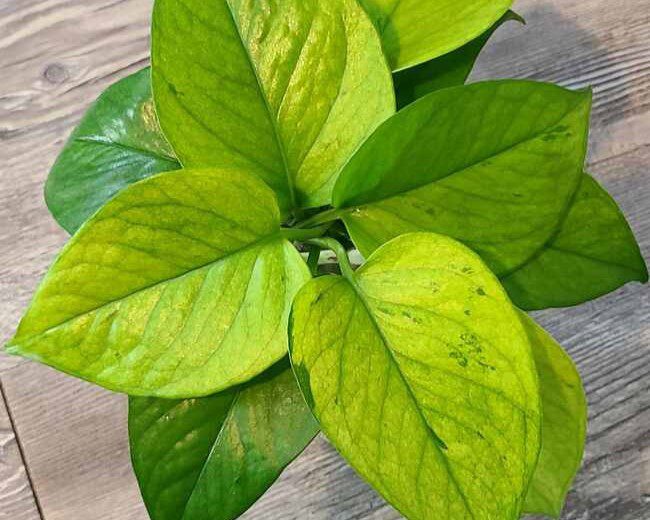
Snow Queen Pothos
Scientific name: Epipremnum aureum “Snow Queen”
Another cultivar with a royal name, just like Marble Queen, is Snow Queen Pothos. On the other hand, because both cultivars share spectacular characteristics, the difference lies in the distribution and spread of the white part. As you can expect from the name, its leaves appear mostly white, not a little creamy, just like “snow”, blended with only a few mottles to denote that the plant also has green shades.
It seems to be one of the most intensely variegated pothos. With such powerful shades of white and little space left for green, the chlorophyll in this pothos is way less than in other plants, meaning it will be a little harder for them to access sunlight’s resources and grow more slowly. Therefore, you should go to greater lengths to care for it and keep it healthy and happy.
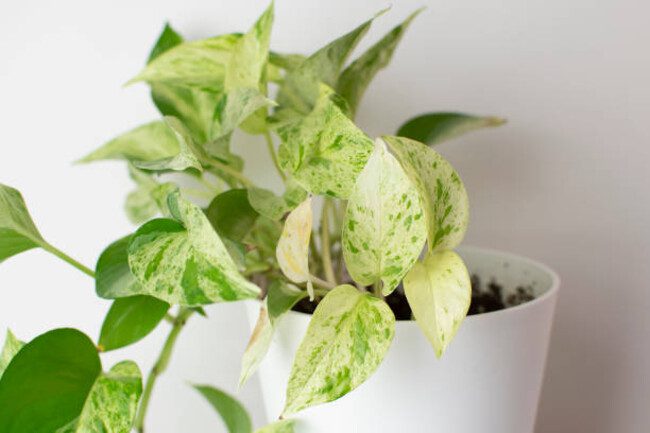
Manjula Pothos
Botanical name: Epipremnum aureum ‘Manjula’
Manjula pothos is unique in that it has a different leaf shape and variegated patterns. This cultivar is a mix of other popular pothos varieties with the typical constitution of dark green with creamy gold or pale olive on the leaves. However, the leaves have a less consistent pattern on the same plant.
The leaves of Manjula Pothos are a little larger and curled at the edges. Therefore, this attribute can be used to recognize the Manjula. Also, the foliage is very special due to the divergence of the leaf patterns; each leaf is variegated in different ways as if they come from different plants.
To keep this amusement, you should take extra care of it because the striking variegation like this means this tree is frailer than normal ones with solid green zones. That is due to the lack of chlorophyll in the leaves, which have little green shades that might cause the tree to absorb energy from sunlight. So take note when the white gradually appears more and more, because that’s a sign your Manjula plant needs more sunlight.
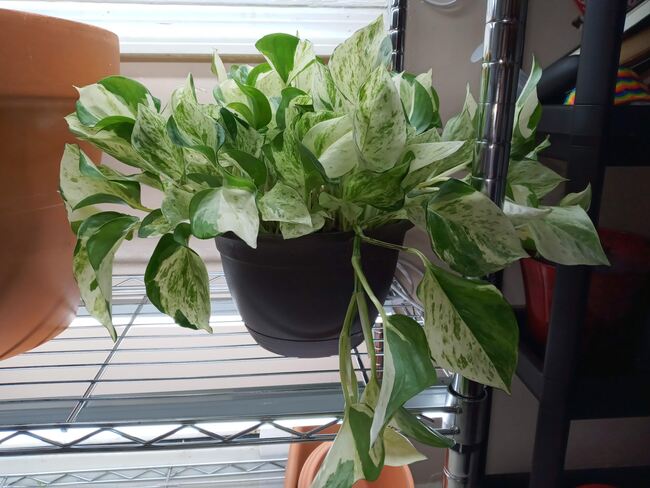
N’Joy Pothos
Scientific name: Epipremnum aureum ‘N’Joy’
This is the kind of Pothos that has been launched recently. It has fairly unique variegation, with large patches of white or cream blocks rather than small spots or streaks lying on the base of the dark green leaves.
The contrast variegated vibe makes the N’Joy Pothos usually be mistaken for the other cultivars, the Manjula (or the Jade and Pearls coming next). You can recognize the N’Joy pothos by its small and cute stature, with smaller leaves borne in tight clusters. Such aesthetics make us feel “enjoyed.” By the way, this pothos grows fairly slowly compared to the others.
To keep the foliage the way it is—gorgeous and outstanding—always give it enough bright, indirect light. The higher the quality of light, the more prominent the white variegation will be.
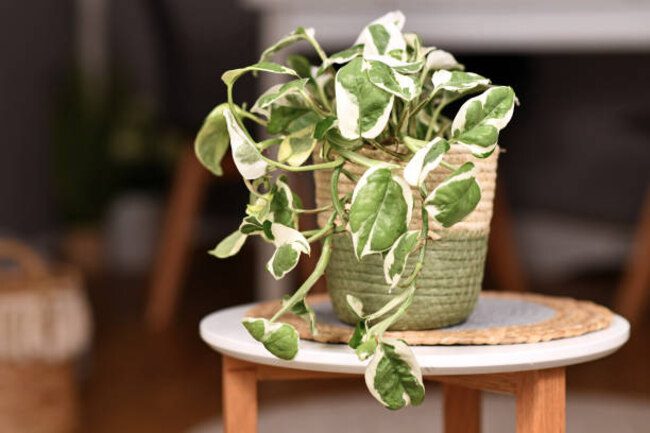
Pearls and Jade Pothos
Scientific name: Epipremnum aureum, ‘Pearls and Jade’
As mentioned earlier, the Pearl and Jade pothos have similar characteristics to the N’Joy pothos, with white cream variegated with deep green in clear figures or solid blocks. However, this variety is even more impressive; its white patches are not randomly spreading like others but are highly organized. The white parts emerge on the edges, forming a border that encloses the green center.
Observe more closely, and you can notice the silvery hues that don’t exist in other pothos, which is so exciting about this plant. Like N’Joy, Pearls and Jade are compact and have a slower growth rate. It matters that taking care of this amazing variegated variety is hard, but you will find it worth it to have such a stunning houseplant like Pearls and Jade Pothos.
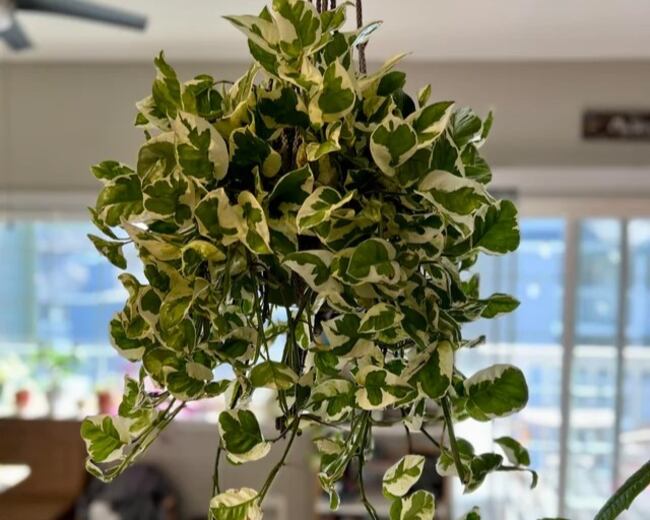
Hawaiian Pothos
Scientific name: Epipremnum aureum ‘Haiwaiian’
Hawaiian Pothos has ornamental chartreuse and gold-coloured bands interleaved with each other, giving its leaves a unique pattern of zebra stripes. The variegation looks more vivid and tense because its leaves are gigantic compared to other pothos varieties. This variegation and color patterns are reminiscent of those of Golden. What differentiates them may be their size. Hawaiian makes a standout houseplant with its large, growing leaves.
You better take some support for its development, such as a moss pole, to train its trailing. Additionally, apply a large hanging basket for an impressive cascading vine feature. The extensive leaves and foliage also increase the advantages pothos bring to our house by purifying indoor air. The plant grows quickly and can easily reach the size of its natural habitat. So prune it regularly to keep the desired size and shape.
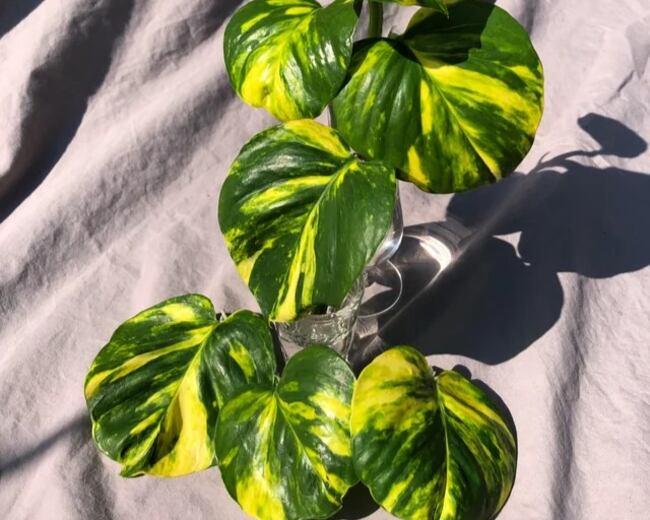
Satin Pothos
Scientific name: Scindapsus pictus ‘Argyraeus’’
As you can tell from its scientific name, it is not really a pothos, but the way it looks remarkably like some true pothos with the confusing similarities in stems, leaf shapes, and variegated patterns is why it is one to mention here. Argyraeus is the most common cultivar in the pothos-neighbouring species, Scindapsus pictus. It was not classified as pothos because of the shades of the variegated streaks. This is white or creamy-gold in pothos but appears as silvery-grey marks that are almost shiny in Satin Pothos.
The leaves are also heart-shaped and have a dark, almost velvety green shade, making them look cozy and solid. You can easily confuse the Satin pothos with its cousin, the Silver Pothos, also a Pothos of Scindapsus Pictus, because they share the same silver tints on the leaves. But they are different in some aspects; the former has a deeper shade of green, while the latter has far more silver, as the name can tell.
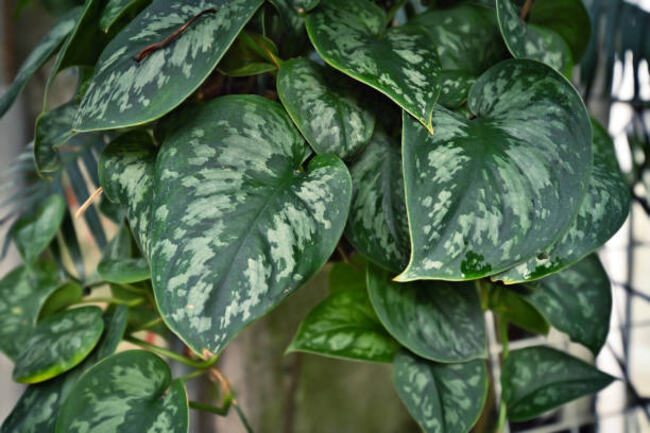
Cebu Blue Pothos
Scientific name: Epipremnum pinnatum ‘Cebu Blue’
While it is still in the same genus, the Cebu Blue Pothos is the first cultivar on this list that falls into the species Epipremnum pinnatum. Jumping to this kind, we can see a great variance in the appearance of pothos from all of the above. You can easily tell by seeing, as its leaf shape and colors greatly differ from those of its cousin, Epipremnum aureum.
Cebu Blue still offers trailing vines as all pothos do, though its leaves are elongated and tend to taper rather than be heart-shaped; sometimes you can imagine them in the exciting shape of arrows. Also, while pothos is usually bright green, Cebu Blue gives a chroma of bluish shades on the dark green background. And when you look at it, you will see that the surface of the leaves seems almost shiny, like metal.
The name is derived from its natural habitat, the Filipino island of Cebu. This pothos has two phases of growth throughout its life: the juvenile phase, which your Cebu Blue is much more likely to stay in because this pothos variety has to be grown outdoors to reach the other phase, the mature phase. At this point, the green leaves might grow large, along with some fenestrations.
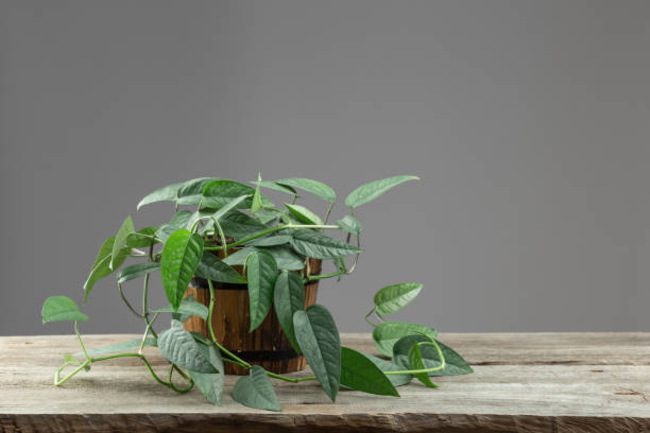
Baltic Blue Pothos
Scientific name: Epipremnum pinnatum ‘Baltic Blue’
Another member of the E.pinnatum species, Baltic Blue Pothos, is also on the list of aroid fans. This clone has leaves that are also narrow and pointy and have the color of solid dark green, with no variegation or streaking at all.
The differences, however, are also dramatic between the two cultivars. Baltic Blue Pothos does not have the silver-shining feeling on its leaves and develops a bluish shade as it ages. But it rather fenestrates as a more common sign than in its E. pinnatum cousin, the variety that only does this when it gets older.
Baltic Blue generally tends to have these fenestration cuts earlier than other pothos varieties. The results of the fenestration-split edges of Baltic Blue are kindly evocative of the monstera plant, specifically the ‘Swiss Cheese” cultivar.
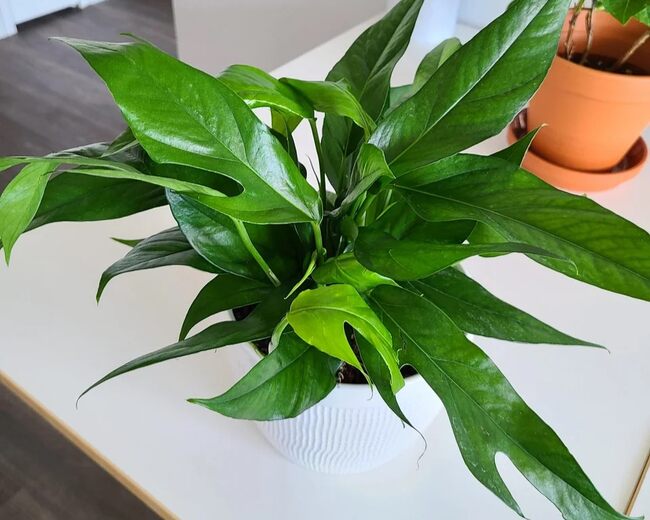
Glacier Pothos
Scientific name: Epipremnum aureum ‘Glacier’
Another cultivar that must be distinguished among many Pothos with analogous looks is Glacier Pothos. You will need a detailed eye to tell this variety apart from N’joy pothos. Having the same regular variegated scheme of colours as the others, Glacier provides a silver hint at the boundary between the green middle parts and white edges. Also, the white figures are streaks and blotches rather than patches or blocks.
Regarding sizes, the Glacier is smaller with more rounded leaves than N’Joy pothos. Another slight difference is that the Glacier’s leaves are a bit shiny all over, whereas the underneath of N’Joy’s leaves is a matte tone of color.
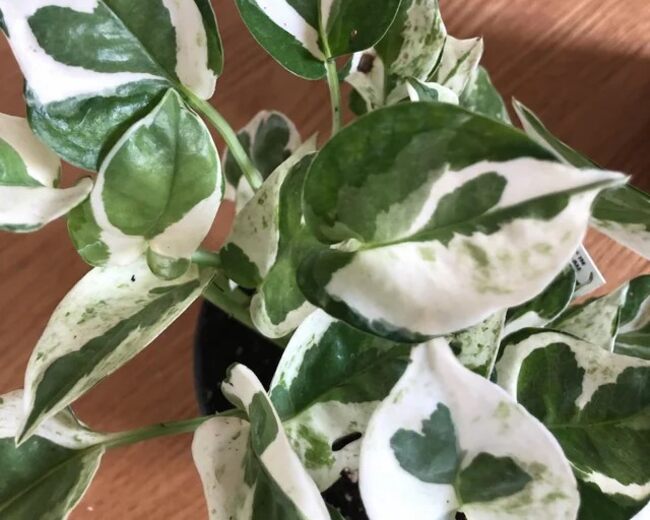
Global Green Pothos
Scientific name: Epipremnum aureum ‘Global Green’
Originally introduced in Japan, Global Green Pothos is by far one of the most recent cultivars in the genus; thus, it is quite rare on the market now. It is variegated in quite a unique pattern that features green-on-green variegation, with dark surrounding the big splotch of lighter green inside.
You can see a few silver tints or cream-white casts on some parts of the leaves sometimes. Unlike the flatness and velvetiness of other varieties’ leaves, the leaves of Glacier feel a little crumpled. Because the color and patterns on the leaves are almost green or a variation of green, they have more chlorophyll than other white-creamy-gold variegated leaves. Therefore, it can be grown quickly compared to other pothos with less green shades, such as Pearl and Jade pothos.
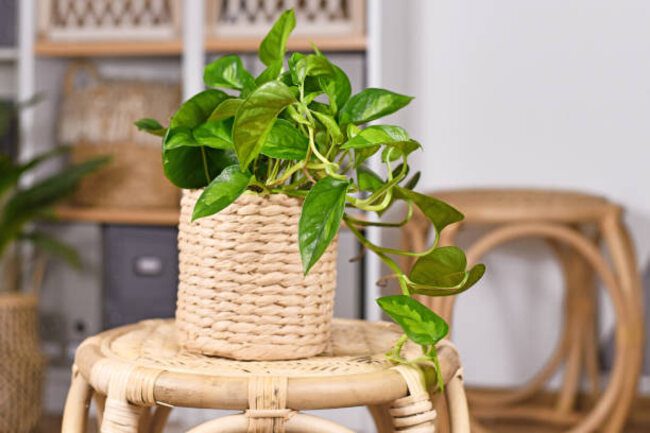
Emerald Pothos
Scientific name: Epipremnum aureum ‘Emerald’
Another unusual variegated cultivar is the Emerald Pothos, like the former Global Green. However, it is the opposite pattern, where the margins are light green and darken towards the center. Also, the blending of the two colors is subtle; it’s a gradual integration of green geared towards a darker shade rather than distinctly delineated.
This softness in appearance makes Emeralds so sought-after for any gardener, even more so than other pothos varieties.
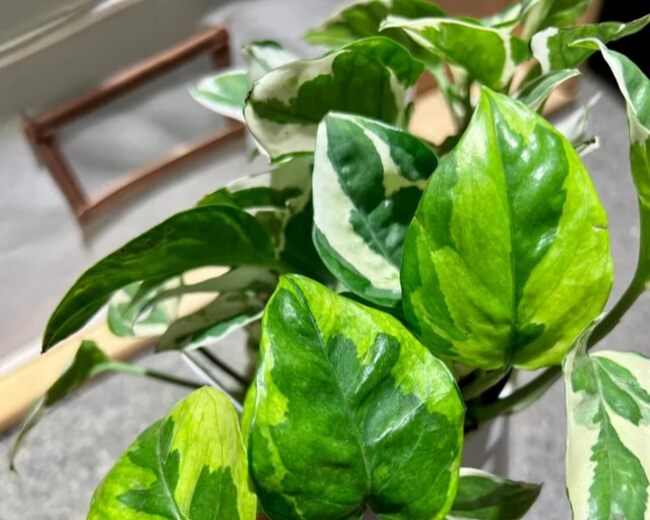
Harlequin Pothos
Scientific name: Epipremnum aureum Harlequin
If there is a rare houseplant you have ever heard rumours about, with its tremendous mystery and striking aesthetic, it should be the Harlequin Pothos. Some enthusiasts even consider it not a distinct cultivar but a branch of Manjula pothos because they are greatly similar in their two-toned appearance.
Except that Harlequin has an extremely greater “white” look than Manjula, sometimes there are entire white leaves with few green splashes. Not having any lime green or creamy gold shades but pure white, it catches your eyes longer than any other pothos, and you definitely can not skip this choice once you hold its beauty.
Although this seems a little confusing because the prominent white blocks mean the plant seriously lacks chlorophyll, the question was being asked: How could this cultivar ever grow or stay alive? As a result, we must go to great lengths and take extra care of such Pothos.
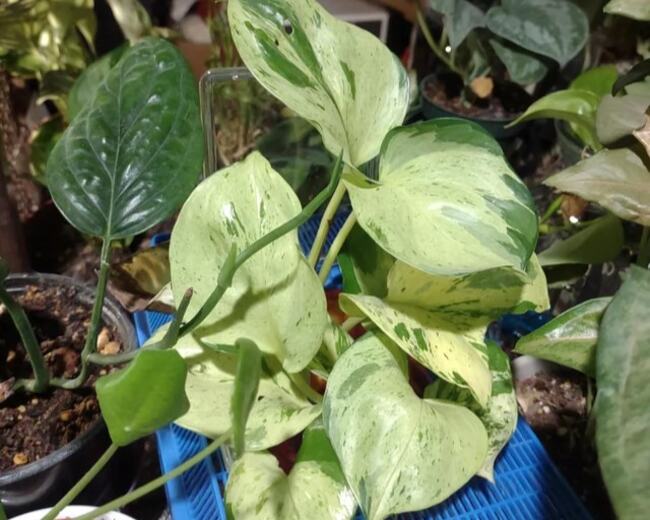
What Is The Rarest Type of Pothos?
Some people might be looking for rare pothos to boost the value of their houseplant collections. Over the years, many gardeners have bred new cultivars that add exciting attributes to the original pothos look. Those are still new individuals and thus low in number, but it’s worth having a plant that few people have.
While the old and traditional varieties of such Golden pothos, Marble Queen are bound in their presence. The others with more unique variegations, like Manjula or Cebu blue pothos, are some kinds that people won’t easily find out about.
Harlequin is the rarest pothos that has just been heard about rather than owned. However, it is still greatly sought-after due to its striking beauty, which none of the other pothos provide.
What Is The Most Common Type of Pothos?
Golden Pothos are the most common, having the longest existence. Therefore, you can easily see one in the market, online, or in some local gardens. They bear the traditional variegated pattern of heart-shaped green leaves blended with golden or creamy white streaks or patches.
Golden pothos has the original name of Epipremnum aureum, where aureum is a Latin word for “Golden”. This name is also the foundation for any other pothos, enough to tell that Golden is the first Pothos that has been produced.
They are also known as Devil’s Ivy because they have a resilient nature towards the environment and are “hard to die” like the Devil. Based on their common problems, you can treat your Pothos since they are low-maintenance and have most issues like other Pothos species. So you can probably grow one beautiful plant and care for it easily.
How Do I Know What Kind of Pothos I Have?
You will easily figure out what your pothos plant is by reading the leaf variegation patterns, which will show you the exact identity of your plant. Of course, it is usually confusing to distinguish between the pothos that are very similar in appearance, like Golden Green vs. Marble Queen or N’Joy vs. Pearls and Jade.
But it might help if you have general ideas about the main variegation patterns usually displayed on them. For example, If it has highly variegated leaves with dark green mixed with many creamy-gold streaks, it is likely the Golden or Marble Queen. Or if it is a pure light green with no variegation, it is definitely the Neon pothos. Or if you see large white blocks in the middle or at the edges, it could only be N’Joy or Pearls and Jade Pothos.
To help your pothos plant thrive, you can fertilize it with a balanced fertilizer once a month during the growing season. Moreover, when choosing soil for your pothos plant, it is important to choose a well-draining potting mix. This will help prevent the roots from becoming soggy and rotting. You can find Pothos fertilizer and soil at most garden centers. Also, read our post about a variety of pothos plants for sufficient and detailed information about all kinds of Pothos and how to determine which one you have by its distinct appearance.
Conclusion
Sixteen pothos varieties are a lot of options, sometimes a bit bewildering for beginners. But on the other hand, you would see this as rewarding because the spectacular world of pothos might care for your natural desire and also fulfil the demand of growing something and seeing it thrive day after day by enthusiastic gardeners.




